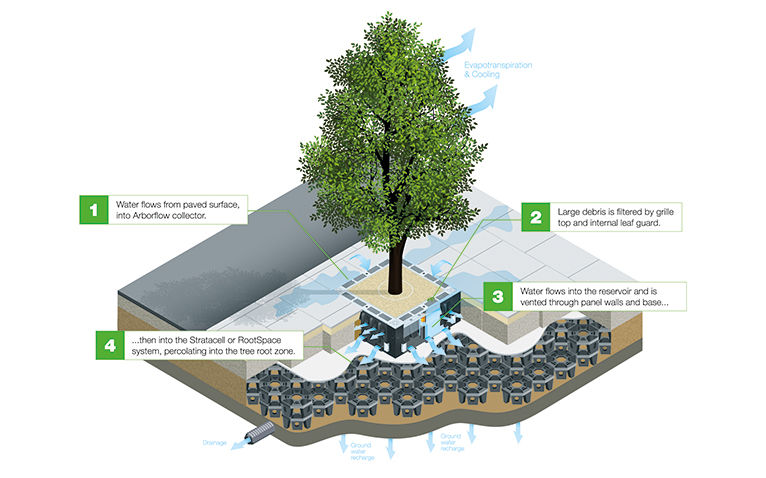For the first time in history, more people live in cities than in rural areas. The intensification of new developments has exacerbated the potentially damaging effects of traditional stormwater management.
The hydrological process that nature intended to manage stormwater, infiltrates rainwater into the ground where it is stored, contributing to soil moisture and groundwater retention. In urban landscapes however, the high percentage of impervious surfaces prevents water from readily percolating into the ground. Instead, surface water runoff is created.

Conventional drainage of surface water runoff was designed to transfer rainwater from where it lands to a soakaway or watercourse as rapidly as possible. However, this method increases the risks of flooding, urban diffuse pollution, and environmental damage, as runoff usually contains contaminants such as oils, chemicals, and other harmful waste.
Improving Surface Water Quality
Research has shown that trees help remove runoff pollutants and contribute towards meeting Water Framework Directive objectives in various ways, including through interception of land pollutants and the reduction of topsoil erosion.
Trees, especially those near watersheds or other drainage areas, protect waterway quality by intercepting water and filtering pollutants. They also trap windblown dust before it enters and pollutes watercourses.

The implementation of sustainable urban drainage systems – demonstrated in outline as well as detailed applications and design submissions – is now being demanded by many local authorities as a prerequisite of planning approval.
Case Study: Twickenham Embankment
Regeneration offers opportunities for environment improvement and civic competitive advantage. It also carries the corollary of a requirement for much greater precision in water management, whether natural or civilization derived.
The Twickenham Embankment regeneration project on the banks of London’s iconic River Thames realised the potential of the location as a local and tourist attraction. GreenBlue Urban worked alongside Richmond Council to devise a scheme to meet the very unusual prevailing circumstances. It depended on the provision of uncompacted, well-drained, irrigated and aerated soil volumes in which trees could thrive and reach their full potential.
The stunted canopy and thin foliage of the previously existing on-site horse chestnut trees deprived the location of a key asset. Daily tidal flooding, inadequate soil volume and poor drainage resulted in tree roots being drowned, yet starved of necessary nutrients and aeration.
The primary requirement, a greatly increased root soil volume, using the GreenBlue StrataCell load bearing support modules imparted great supporting structural strength underpinning highways and pavement areas. Freed from soil compaction risks, the roots of the eight new semi-mature Pin Oaks have optimum growth conditions. Councillor Pamela Fleming, Richmond Council Cabinet Member for Environment, commented “Twickenham now has a riverside to be proud of… for people to walk along, view from the river, or just sit and enjoy.”
Similar applications of sustainable drainage have resulted in the development by GreenBlue Urban of modular SUDS / LID systems. These expedite and reduce the cost of creating viable eco-systems flexible enough to maximize the potential of any size of location, space and planting plans.
Proving and Increasing LID/SUD Schemes
GreenBlue Urban have conducted collaborative research with universities, professional laboratories, and local authorities across Europe, North America, and Australasia in order to anticipate, identify and innovatively overcome obstacles likely to impede full implementation of LID techniques.
If landscape architects and related LID practitioners don’t get this right, in 10 to 20 years’ time the civil engineering community will be saying “we told you so”
Craig Applegath, Founding Principal at DIALOG, an award-winning multi-disciplinary design firm with offices across North America, said at the 2016 Grey to Green Conference, “The twentieth century was the century of building architects, but the twenty-first century is the century of landscape architects.”
Time will prove the candour of this statement, but in any case, the beauty of the evolution of sustainable urban drainage is the demise of the old lines of demarcation in favour of a convergence of the two disciplines. Mutual recognition of the value added to projects through embracing the multiple and wide-ranging benefits of biophilic design, including SUDS / LID, has resulted in amazing urban spaces worth far more than the sum of their parts.
ArborFlow SUDS Tree Pit System
The ArborFlow urban drainage system was developed as a sustainable, efficacious, and environmentally robust process of managing surface water runoff. It is ideal for use in heavily urbanised areas where space is at a premium. ArborFlow provides attenuation within the tree pit as well as absorption into the surrounding ground and through the tree’s root system.

GreenBlue Urban’s ArborFlow system significantly reduces the velocity and flow rate of surface water runoff, and can be designed to assist with meeting discharge rates allowed and set by regulatory authorities.

ArborFlow’s design allows the water to be either discharged into surrounding subsoil for root absorption, or to find its way into the specially designed flow-control chamber positioned on the outfall of the tree pit.

